The Blob and the Bees
Are they dangerous or merely weird?
Welcome to all our recent subscribers! Natural Wonders is a featured newsletter on the Substack main page at the moment, so we’ve added a couple hundred new friends to the community! If you enjoy this issue, please click the share button at the bottom of the page and send a link to a friend or Tweet it to your nearest and dearest.
Within a few short days last week, I experienced two unusual outdoor occurrences at my house. I mean, beyond 15 of the neighbor’s cows and calves escaping to trample our yard and Andrew startling a batch of baby birds to leave their nest early and the mating lizards on the front step. I’m talking about two extra-weird things we discovered, the first of which was…
The Blob
Andrew and I were mowing, weed-eating, and generally cleaning up our area near the creek when out of the corner of my exhausted, sweaty eye I caught sight of a strange black blob clinging to a blade of grass. Thinking it might be a group of eggs from some insect, I crept closer, and then this happened:
What in the world? I knew I had to find out:
What is this black blob and is it dangerous?
If you look closely, you can see the blob is made up of over 100 tiny spiders. When they’re this tiny, they’re called “spiderlings,” and they are probably a type of orb weaver. The eggs were originally in a sac similar to this one our resident writing spider created last fall:
The babies live for a while inside this egg sac until they grow slightly larger and need to molt and shed their older, too-small skin (or exoskeleton). In the photo above, you can see the white castings of their first molting. At this point, the spiderlings hatch from the sac by cutting it with their tiny fangs and eating a hole into the side. They then live clustered together nearby, surviving off the egg yolk they’ve digested.
I missed the hatching of the writing spider’s egg sac above (I was really disappointed – but they snuck out during an early warm spell this spring when I wasn’t expecting it). The black blob I saw in the yard had evidently hatched from a different sac that wasn’t immediately obvious, and the babies were hanging out together entertaining themselves by “exploding” their blob whenever a possible predator disturbed their habitat.
The spiderlings only stay together in this blob for a short while before it’s time for them to embark into the great, wide world. Usually, they do this by either “ballooning” or “bridging.” When they balloon, they stick their rear ends up into the air and release a strand of silk to catch the wind. In this way, they can travel a few yards or up to 100 miles (Charles Darwin found ballooning spiderlings on his ship The Beagle while 100 km out to sea). Or some species disperse by forming bridges of silk strands by swinging between branches and creating highways for the babies to travel upon.
Which did our black blob do? Well, take a look at what happened:
Hopefully, these spiderlings will survive to help control the insect population in our yard this summer. They can eat around 2,000 insects a year, and so are really good to have around.
The Bees
Speaking of insects that may or may not be good to have around, our second weird phenomenon was an infestation of bees that suddenly appeared in the yard, creating dozens of holes:
They swarmed everywhere and made a loud humming noise, but I could squat down amongst them and they completely ignored me:
What are these things? And should I be worried about getting stung?
It turns out these are Miner Bees, so-called because they are known to dig holes. They’re also known as Digger Bees, Chimney Bees (because they build little chimneys above the ground at the entrance to their home) and Mustached Mud Bees (because the males have tiny mustaches that contain pheromones to attract the females), like miniature Tom Sellecks.
Miner Bees are not a hive species – each little hole is the home of a separate queen who will lay her own set of eggs. The holes are about 15 cm deep and have little turrets or chimneys the queen forms by balling up mud from the dirt she’s excavating.
These bees usually show up in the spring for just a few short weeks – the queens live about 4-6 weeks and the males only half that long. The queens lay their eggs and leave the babies a collection of pollen to feed on. The babies hatch in a few weeks, but live underground over the winter until they emerge next spring to start the process over again.
While they can seem a little intimidating with all the buzzing and flying, they aren’t prone to stinging and are actually quite docile. The queens have tiny little stingers that usually can’t penetrate human skin, and the males don’t even have stingers. Miner Bees’ little holes act as aeration for your yard, so it’s generally just best to let them be for the short time they’re around. They’re also great pollinators, and the more of those we can get, the better.
Have you ever encountered either of these phenomena? A blob of spiderlings or miner bees? (I kind of prefer the name Mustached Mud Bees) Or something else really weird in your yard? Leave a comment and tell us what happened:
Nature Break: Find a small section of forest or your yard, squat down and check out the insect life in that little patch of the world. Insects are the largest group of organisms on Earth – there are 10 quintillion insects living at any one time (that’s a one with 19 zeros). Which ones can you find near you? Where do they live? Are any of them eating? Can you anticipate how that particular insect might be helping the ecosystem?
Weird Nature of the Week
Turn your sound up!
Detritus
If you wondered what would have happened if I’d picked up the exploding blob if it were ten times bigger, check out this video.
Some parts of the world are nearing an insect apocalypse because of declining numbers of critical species. In some cases, numbers have declined by 50%. The loss of pollinators could have a huge impact on our ability to grow crops.
“For the second time in three years, Mazda Motor Corp has issued a recall for Mazda6 sedans in North America because of a spider that likes the smell of gasoline and weaves a web that blocks a vent in the engine.”
If you enjoyed this issue, please click the “like” button below - it helps raise the profile of the newsletter and makes it easier for others to find it. And please share it with your friends!


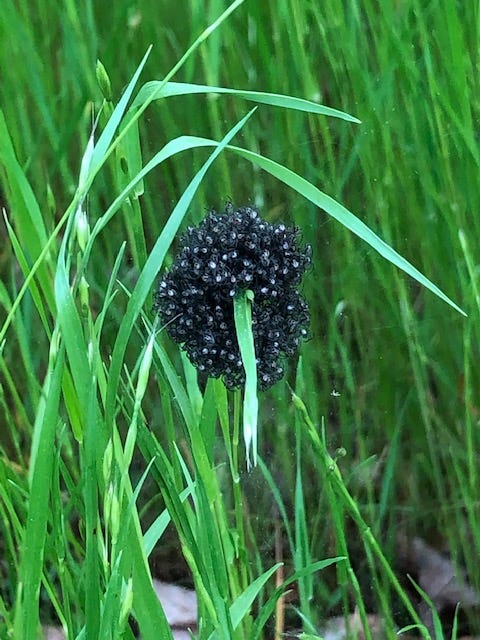
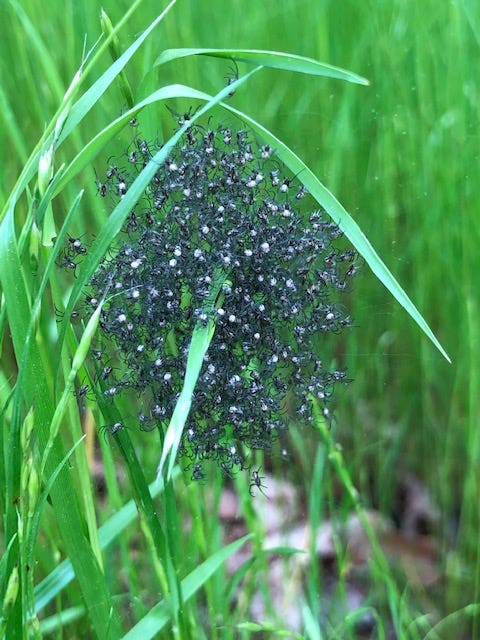

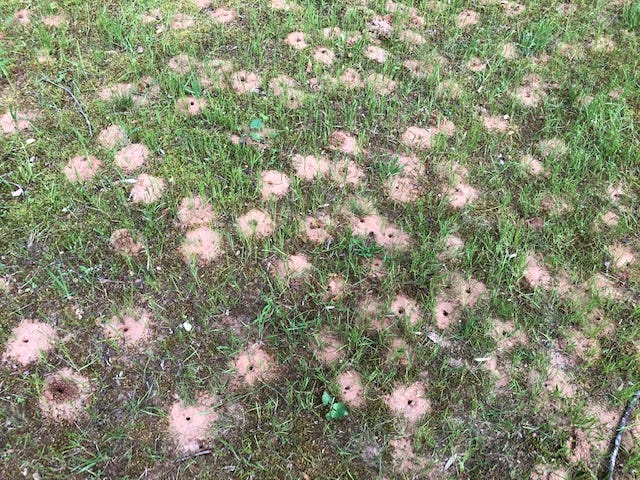
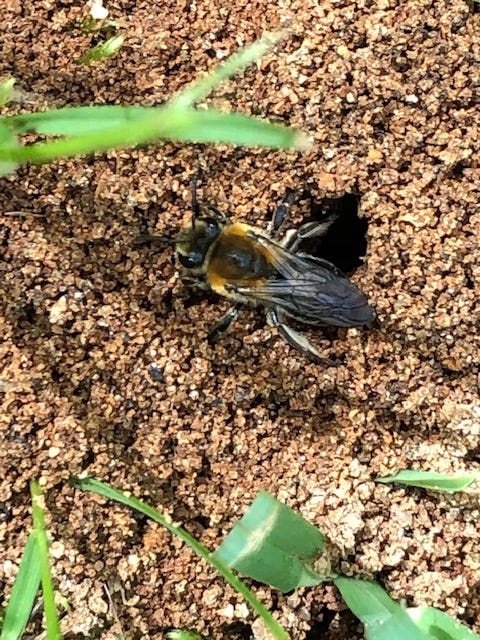
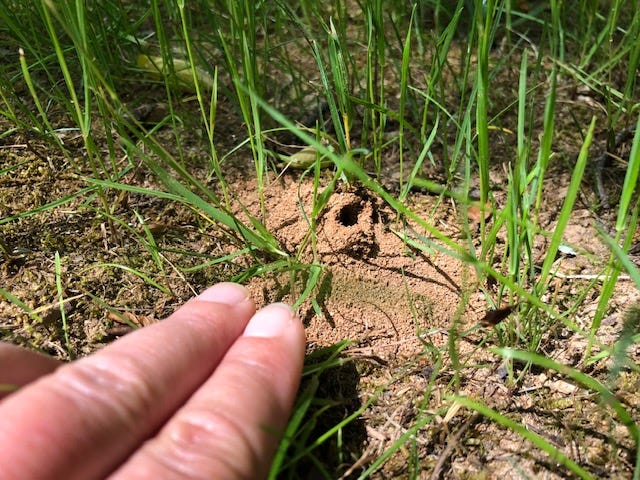

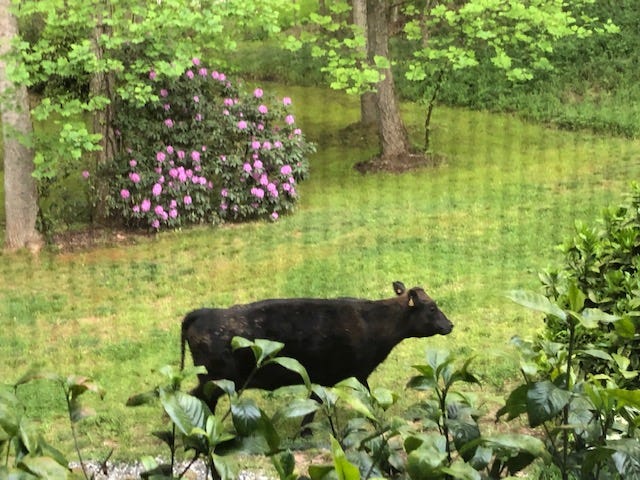
Two of the city parks here in Tallahassee have large populations of miner bees, numbering in the many thousands. The bees open their burrows in late February or early March and forage for nectar and pollen with which they stock their nest. Males form chaotic, low level swarms over the open female nests, and pounce females to try to mate with them. I think success is probably low. By the end of March, the bees have closed their burrows again, not to reappear until next year.
You know what has an amazing diversity of insects and other creatures? A compost pile! I even found snails in ours!